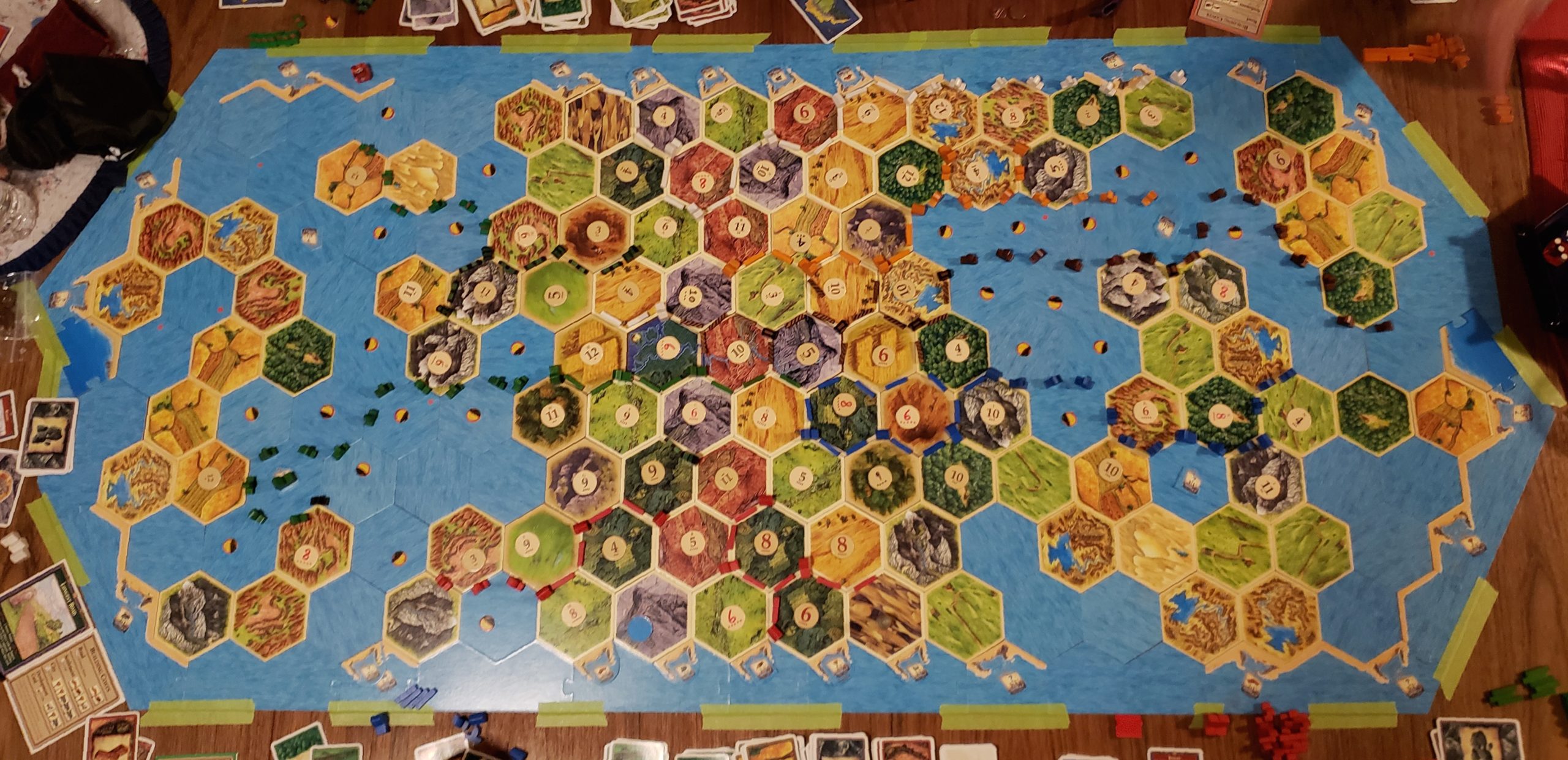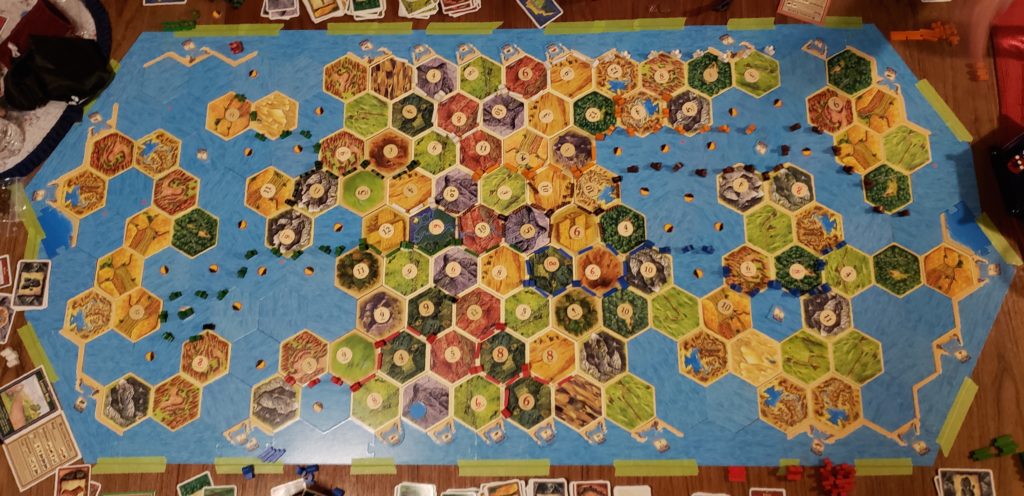Wizard Tag

Despite our penchant for following game rules, we tend to have a lot of “House Rules”.
These are not normally changing the basic game play, but rather enhancements of things we like.
Our favorite example of this is with our house-version of Catan.

Making Catan Bigger with House Rules
Normal Catan is like exploring a country, our house rules let you explore a continent!
- Scarce resources.
- Everyone hates deserts.
- Everyone hates rolling the Robber Baron.
- Catan expansions only allow up to 6 players.
- We usually want to keep the game going after someone gets to 10 points.
And we wanted to include these features that we liked:
- Ports for trading.
- Hidden land from Seafarers.
- Gold lands from the River Expansion.
- Trade routes with ships from Seafarers.
- Victory points for each person’s first island discovery.
How we addressed each issue or feature through house rules.
Issues:
- Scarce resources: The map was huge and even with 8 players, nobody was blocked completely. Since 8 people rolled for resources each round, by the time it was your turn, you had plenty to build with. To speed up the start of the game, each person was given three settlements, three roads, and 2 ships (prepaid for later use).
- Everyone hates deserts: There were just way too many desert tiles, no one likes exploring only to find a desert. So, we kept a few desert tiles, and turned the rest into gold tiles. Everyone likes finding gold.
- Everyone hates rolling the Robber Baron: The problem was you could build a huge hand of cards just waiting for your turn, and it was a real pain to lose half. We decided that rolling a 7 during the resource phase does not activate the Robber or Pirate during the first few rounds. We started with 2 rounds, then increased it to 4, and one time even went to 6. Until we decided, the Robber Baron would not become active until someone discovered a desert tile. However, this mechanic was still an equalizer, like in the smaller version, and it became an incentive to spend or trade your resources as much as possible on your turn.
- Catan expansions only allow up to 6 players: We solved this by making the extra 2 sets of pieces, but found that even with focused players, even 5 people slows down the game a lot. Playing with 8 was still fun!
- We want to keep the game going after someone gets to 10 points: This was easy to fix. We just made a house rule that the game goes to 12, then increased it to 14, and finally to 15. For the giant-Catan, 15 ended up being right.
Features we liked:
- Ports for trading: Some people love ports and some don’t care. We wanted the options, because it meant more construction. With so many players, there was usually someone willing to do a reasonable trade. We found that when people had ports, they preferred to do their own trades to avoid helping their opponents! The ports we placed in the east and west didn’t get much use since it took so long to get there, so we made “floating” ports on random sea tiles that you could discover while flipping tiles.
- Hidden land from Seafarers: Our favorite part of seafarers was flipping the tiles, and we have a pouch where you draw the number tile to place on the land tiles. This helps to randomize the play and prevent people from strategizing since they don’t know where certain resources will be or what numbers they’ll be assigned. This changed the game from “Settlers” of Catan more towards “Explorers” of Catan. This was easy and very popular. We just put some of the tiles upside down. Everyone loves this discovery feature. Some people built huge trade routes just to flip tiles and try to find that elusive gold island!
- Gold lands from the River Expansion: The gold lands produce whatever resource you want when their number comes up. When a gold tile was discovered, there was usually a rush to get there and build a settlement. We added all the gold tiles we had and then converted some deserts to gold.
- Trade routes with ships from Seafarers: Since it was possible to place a ship next to a settlement that was on the water’s edge, only to find out later it was land, we decided that the ship was on a river and that connection remained just like a road. Sometimes this could leave a ship stranded, and that was just bad luck!
- Victory points for each person’s first island discovery: Probably the coolest thing about this victory point is that you can lose it. When you discover your first island, you get a victory point, but if it is later revealed that it was not an island, but an uncharted peninsula, then you lose that victory point. This brought a lot of laughs. You can see from the picture that there were 4 true islands and one peninsula which fooled a player. Brown-stripe discovered the island, but when Blue crossed sea to explore, the single connecting tile was discovered that made it into a large peninsula with a small lake in the middle!
What do you need to make a continent in Catan?
We set about putting together the game with all of our available tiles. We bought a couple of 5-6 expansions, then borrowed tiles from my Dad’s sets. You can see that we had a nice ratio of sea to land tiles, about 1:1.
Since the expansions only had pieces for 6 players, we drew stripes on spare sets of green and brown pieces to make two new “colors” allowing us to use 8 players with boats.

Instructions for setting up our House Rules Catan Continent.
It took some planning to get the ratios of lands and numbers correct.
- Build the “center” of the main continent with two of each of the five land type tiles.
- Add an area around the center with upside down land tiles, five of each kind. This is the “unexplored” area of the continent.
- Add the “sea”. These tiles could be either water, land, or floating ports (attach spare port pieces to a water tile). We basically randomized all the leftover tiles we had.
- Build the border around the tiles, and, the most important part, secure the border with masking tape. It’s not necessary, but without it, the tiles and borders tend to get jostled during play.
- Sort the number tiles into three groups for the different areas: center, unexplored, and sea. The center has numbers with better odds for rolling to help players in the beginning (so exclude the tiles with lower odds like 2 & 12, and 3 & 11, and add more with higher odds like 6 & 8, and 5 & 9). The unexplored should have a little more equality with the numbers in terms of good and bad rolling odds. For the sea, take the number tiles and make a pyramid styled tapered selection, so there were fewer of the numbers with lower odds and more with higher odds. Put the number tiles for the center and unexplored upside down randomly on the tiles. Place all the numbers for the sea upside down, so they can be randomly selected when land is discovered.
- Optional, give each player their own set of dice to increase the randomness of the roles.
Share your thoughts in the comments below!
- What’s your favorite house rule for a game?
- Let us know if you try our Catan house rules!

Want more Wizard Tag updates?
Follow our Progress as we create Laser Tag for Wizards!
#makingmagicreal
Browse the Latest Blogs:

Game Review: The Vale of Eternity
- 6 min read
- Date: May 12, 2024

Game Night: Root
- 4 min read
- Date: May 5, 2024

Wizard Tag Web Design
- 4 min read
- Date: April 28, 2024
We have a house rule about moving roads. You need a brick, a wood, and a sheep. The sheep haul the road to the new location.
Nice! If you have a house rule such as “moving roads” and everyone likes it, that’s great! (In your house…) Heheh! Also, when it comes to making house rules like that, if someone asks, “Well, why can’t I move the road?” and there’s no good answer, then try the new rule. What I like about yours is that there is an extra cost, and thus a consequence to making a bad decision earlier.
You got to experience our Giant Catan version and hope other people will give it a try too!